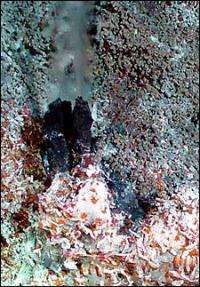Some like it hot: Deep-sea worms seek temperatures higher than those preferred by any other known species

Scientists have found that worms dwelling at deep-sea hydrothermal vents opt for temperatures of 45-55 degrees Celsius (113-131 degrees Fahrenheit) when provided a choice of conditions, giving them the highest thermal preference of any animal studied to date. This unique preference for extreme temperatures may be the undersea worms' meal ticket, because they are apparently the only animals able to access - and feast on - lush mats of bacteria that thrive around deep-sea vents.
The research was described last week in the journal Science.
Authors Peter R. Girguis of Harvard University and Raymond W. Lee of Washington State University studied Paralvinella sulfincola, a member of the Alvinellidae family of worms dwelling at ocean depths of some 2,200 meters off the Pacific coast of Washington. When the researchers placed the worms within a special high-pressure seawater aquarium with a sharp temperature gradient, these worms chose to remain at roughly 50 degrees Celsius for the duration of a seven-hour experiment.
"This is far longer than animals have survived other thermo-tolerance studies, where scientists exposed individuals to high temperatures for 15 to 30 minutes, as long as it took for half of them to die," says Girguis, assistant professor of organismic and evolutionary biology in Harvard's Faculty of Arts and Sciences. "Unlike many animals found in hot habitats, which merely tolerate extreme temperatures, these worms actually prefer temperatures around 50 degrees Celsius."
Girguis likens the worms' deep-sea habitat to a pot of scalding water heating inside a freezer. At extreme undersea pressures, water will not boil, so deep-sea thermal vents jet out water that remains liquid at temperatures of up to 350 degrees Celsius (662 degrees Fahrenheit). Because the surrounding seawater is barely above freezing, a steep and variable temperature gradient exists around the thermal vents, making it difficult to measure precisely the deep-sea temperatures survived by Alvinellid worms.
Rather than taking submarine-borne thermometers to the worms' remote habitat, Girguis and Lee brought the worms to their special aquarium, leaving the deep-sea creatures free to choose any temperature between 20 and 61 degrees Celsius (58 and 142 degrees Fahrenheit). When this thermal gradient was established, all the worms migrated to parts of the tank registering 45 to 55 degrees Celsius.
For seven hours the worms chose to remain at around 50 degrees Celsius, performing their normal behaviors. Other inhabitants of equally inhospitable environments are known to die fairly quickly under such conditions; in one previous study of desert fire ants, all died within one minute of exposure to a temperature of 55 degrees Celsius. Such ants will survive brief forays into similarly hot areas to obtain food, but do not choose to remain in superheated environs as Alvinellids do.
"We speculate that these worms have evolved to prefer and tolerate these temperatures because it allows them to graze on bacterial lawns that no other organism can access," Girguis says. "Bacteria can survive much higher temperatures than animals, and often grow in lush mats, or lawns, in areas too hot to support animal life."
Source: Harvard University, by Steve Bradt















